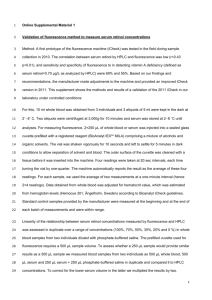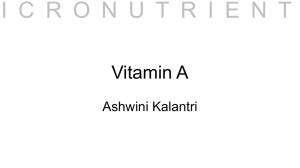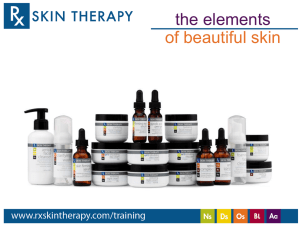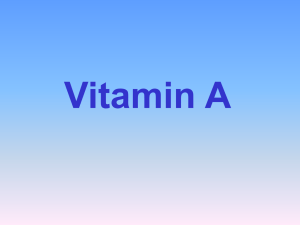Simultaneous determination of retinol, carotenoids and tocopherol in
advertisement
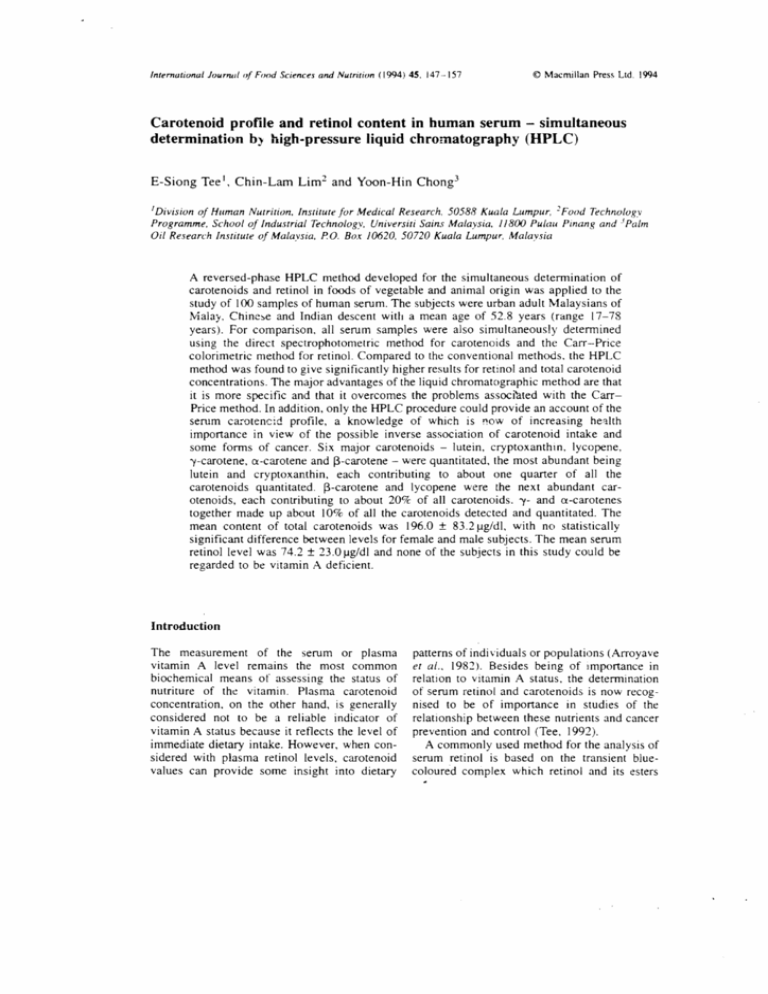
International Journal of Food Sciences and Nutrition (1994) 45, 147-157
© Macmillan Press Ltd. 1994
Carotenoid profile and retinol content in human serum - simultaneous
determination b) high-pressure liquid chromatography (HPLC)
E-Siong Tee I, Chin-Lam Lim 2 and Yoon-Hin Chong)
JDivision of Human Nutrition. Institute for Medical Research, 50588 Kuala Lumpur, :: Food Technology
Programme. School of Industrial Technology. Universiti Sains Malaysia. JJ 800 Pulau Pinang and 3 Palm
Oil Research Institute of Malaysia, Po. Box 10620. 50720 Kuala Lumpur, Malaysia
A reversed-phase HPLC method developed for the simultaneous determination of
carotenoids and retinol in foods of vegetable and animal origin was applied to the
study of 100 samples of human serum. The subjects were urban adult Malaysians of
Malay. Chim~~e and Indian descent with a mean age of 52.8 years (range 17-78
years). For comparison. all serum samples were also simultaneously detennined
using the direct spectrophotometric method for carotenoids and the Carr-Price
colorimetric method for retinol. Compared to the conventional methods. the HPLC
method was found to give significantly higher results for retinol and total carotenoid
concentrations. The major advantages of the liquid chromatographic method are that
it is more specific and that it overcomes the problems associ'ated with the Carr­
Price method. In addition, only the HPLC procedure could provide an account of the
serum carotencid profile. a knowledge of which is !10W of increasing he<llth
importance in view of the possible inverse association of carotenoid intake and
some forms of cancer. Six major carotenoids
lutein, cryptoxanthlO, lycopene,
'Y-carotene, (X-carotene and f3-carotene - were quantitated, the most abundant being
lutein and cryptoxanthin, each contributing to about one quarter of all the
carotenoids quantitated. f3-carotene and Iycopene were the next abundant car­
otenoids, each contributing to about 209C of all carotenoids. "1- and (X-carotenes
together made up about 10% of all the carotenoids detected and quantitated. The
mean content of total carotenoids was 196.0 ± 83.2 Jlg/dI, with no statis[ically
significant difference between levels for female and male subjects. The mean serum
retinol level was 74.2 ± 23.0 Jlg/dl and none of the subjects in this study could be
regarded to be vitamin A deficient.
Introduction
The measurement of the serum or plasma
vitamin A level remains the most common
biochemical means of assessing the status of
nutriture of the vitamin. Plasma carotenoid
concentration, on the other hand, is generally
considered not to be a reliable indicator of
vitamin A status because it retlects the level of
immediate dietary intake. However, when con­
sidered with plasma retinol levels, carotenoid
values can provide some insight into dietary
patterns of individuals or populations (Arroyave
et ai., 1982). Besides being of lmportance in
relation to vitamin A status, the determination
of serum retinol and carotenoids is now recog­
nised to be of importance in studies of the
relationship between these nutrients and cancer
prevention and control (Tee, 1992).
A commonly used method for the analysis of
serum retinol is based on the transient blue­
coloured complex which retinol and its esters
148
£-S. Tee et al.
form under anhydrous conditions with anti­
mony trichloride-chloroform reagent (Carr­
Price reaction). Other colour reagents used
include trifiuoroacetic and trichloroacetic acid.
The major problem with the use of these
methods is the evanescent nature of the blue
colour obtained. posing considerable practical
difficulty in taking readings in a colorimeter.
For the determination of carotenoids in serum.
the common method is to read the absorbance
of the hexane extract at 450 nm. Results so
obtained would. at best. be referred to as total
carotenoid concentration.
In recent years. high-pressure liquid chroma­
tography (HPLC) has become more widely used
for the analysis of carotenoids and retinol.
mainly because of the greater specificity of the
technique (Tee & Lim. 199 Ia). A simple
reversed-phase HPLC method has been devel­
oped by the authors in an effort to develop
improved methodologies for the separation and
quantitation of carotenoids and retinol in foods
and biological specimens. especially blood
serum. The method has been used successfully
for the analysis of major carotenoids in Malay­
sian fruits and vegetables (Tee & Li m, 199 Ib)
and the simultaneous determination of retinol
and several carotenoids in foods of animal
origin and processed foods (Tee & Lim. 1992).
This paper reports the application of the same
method for the simultaneous analysis of car­
otenoids and retinol in serum. The samples were
also simultaneously determined using the direct
spectrophotometric method for carotenoids and
the Carr-Price method for retinol.
Materials and methods
Soh'ems and standards
Analytical-grade solvents were used for sample
preparation. whereas solvents for high-pressure
liquid chromatography were of HPLC grade.
All solvents for use as the mobile phase in
HPLC were filtered through a 0.45 11m regen­
erated cellulose membrane filter and degassed
using an ultrasonic bath.
a- and ~-carotenes. lycopene and retinol
standards were purchased from Sigma Chem­
ical Company. ~-Carotene. cryptoxanthin. and
lutein were gifts from F. Hoffmann La-Roche.
Switzerland. Stock solutions of the carotenoids
were prepared in hexane (except that lutein was
prepared in ethanol) and retinol in ethanol. in
concentrations of 100 I1g/ml and stored in amber
bottles below -20°C. Working solutions of
I l1g1ml of the standards were prepared daily.
For standards from Sigma. the appropriate
absorptivities (extinction coefficients) given by
the company were used to calculate the exact
concentration of each of the compounds. For
other carotenoids. absorptivities published in
the literature (De Ritter, 1981) were used.
Absorbance readings and absorption spectra of
all standard solutions were monitored daily. The
preparation of all standard solutions was carried
out rapidly. in a room with subdued light and
with all windows tinted with a light-protective
film. All sample treatment and analytical proce­
dures were also carried out in this room.
Samples and sample preparation
Semm retinol and carotenoid concentrations,
Blood samples se'nt to the laboratory for
determination of serum lipid profile were selec­
ted based on the following criteria: (1) samples
were from apparently healthy subjects who
requested routine medical examination; (2)
samples were collected on the same day: and (3)
sufficient volume was available. Blood samples
meeting these criteria were allowed to clot and
the sera separated by centrifugation. Aliquots of
the sera from these samples were immediately
taken and stored in the dark at -20°C. The
samples were analysed within 1 week of
collection.
Serum samples were processed for analysis
using the following procedures. Into glass­
stoppered 15 mt centnfuge tubes were added in
sequence. 0.5 rnl serum. 1.5 ml distilled water,
and 2 ml 9.5o/c ethanol and the contents were
mixed in a vortex. After the addition of 3 ml
petro'leum ether (b.p. 40-60°C). the tubes were
stoppered and shaken vigorously for 2 min. The
tubes were centrifuged for 5 min and .2 ml of the
top petroleum .:ther layer (test solution) pipetted
out for analysis by the HPLC mc!thod.
Comp(/rative stud,v of different analyrical meth·
ods. Left-over human sera sent to the labo­
ratory for determination of serum lipid profile
were pooled for comparative studies of the
HPLC method. the direct spectrophotometric
me'thod and the Carr-Price method for the
analysis of carotenoids and retinol. Sera that
\vere stored for more than 5 days in the
refrigerator were not used.
Carotenoid profile and retinol content in human serum
Aliquots of the pooled sera were processed as
follows for the comparative study. Into each of
four glass-stoppered 15 ml centri fuge tubes
were added 1 ml serum and I ml distilled water
and processed as described above. After cen­
trifuging the tubes, 2 ml of the top petroleum
ether layer (test solution) were pipetted out
from each tube and pooled for the required
analyses. Two 2 ml aliquots of each of the test
solutions were determined by the direct spec­
trophotometric and the Carr-Price methods for
total carotenoid and retinol respectively.
Another two 2 ml aliquots of each of the test
solutions were analysed by the HPLC method
for simultaneous determination of several car­
otenoids and retinol. In this way, l'ml aliquots
of pooled sera were determined in duplicate by
each of the two sets of methods.
Extractant for retinol and carotenoids. Pooled
sera were also used for a study of the effect of
using the HPLC mobile phase instead of
petroleum ether for extracting retinol and car­
otenoids from the sera. Retinol and carotenoid
concentrations were simultaneously determined
using the HPLC method.
High-pressure liquid chromatography method
HPLC conditions. A Gilson liquid chromato­
graph (Gilson Medical Electronics Inc .. Mid­
dleton. USA) equipped with a 305 pump was
used. A Gilson 116 UV detector set at 325 nm
was connected in series with a Waters 440
fixed-wavelength detector (Millipore Corp..
Milford. USA) at 436 nm to enable the simulta­
neous detection of retinol and carotenoids. A
stainl·ess steel 30cm x 3.9 mm (i.d.) IlBonda­
pak -C 18 column (Millipore Corp .. Milford.
USA) was used for the chromatographic separa­
tion. This column was preceded by a pre­
column module housing a disposable pre­
column insert packed with the same material as
that in the analytical column. The mobile phase
used consisted of a ternary mixture of acetoni­
trile. methanol and ethyl acetate (88: 10: 2. v/v).
delivered at a rate of 2 mllmin. The sample
injection volume, dispensed with a Rheodyne
7125 injector (Rheodyne Inc.. California.
USA), was usually 50 Ill. Data were analysed
and stored using a Gilson 714 HPLC system
controller software (Gilson Medical Electronics
Inc .. Middleton. USA). operating in a IBM-AT
compatible microcomputer.
149
Chromatograph)' of ca roteno ids and reti­
nol. Two 2 ml aliquots of the test solution
were evaporated to dryness in a 50°C water­
bath with the aid of a stream of nitrogen. The
residues were immediately re-dissolved in 2 ml
mobile phase. After filtering thwugh a 0.45 IJm
membrane filter, aliquots were injected into the
HPLC for simultaneous detection and quantita­
tion of retinol and carotenoids.
Peak areas of retinoL ex- and f3-carotenes, and
lycopene were quantitated and their concentra­
tions calculal.cd using reference standards of
these compounds similarly chromatographed.
Total peak area obtained at 436 nm for each
sample was u sed for calculating total carotenoid
concentration in the sample.
Direct spectropho~ometric and Carr-Price
methods
The direct spectrophotometric and the Carr­
Price methods were essentially as those given in
the ICNND manual (lCNND, 1963). Two 2 ml
aliquots of the test solution were placed in lOX
75 mm cuvettes and the absorbances read
immediate:ly in a spectrophotor::1eter at 450 nm
against a petroleum ether blank. Total car­
otenoid concentrations were calculated from the
absorbance reading using a calibration curve
prepared using a f3-,;::arotene standard.
In the following determination of retinol for
the two test solutions. each solution was
analysed separately after completing one sam­
ple. The test solution in the cuvette was
evaporated to dryness in a 50°C water bath with
the aid of a stream of oxygen-free nitrogen. The
residue was immedilately re-dissolved in 0.1 ml
chloroform. and one drop of acetic anhydride
was added. The spectrophotometer was set to
620 nm and zeroed using a reagent blank
consisting of I ml antimony trichloride reagent
(209c antimony trichloride in chloroform).
0.1 ml chloroform and one drop of acetic
anhydride. The tesc cuvette was placed in the
spectrophotometer and I ml antimony trichlo­
ride reagent was delivered rapidly into the tube.
The absorbance reading was taken at the pause
ppint. 'about 3 s after the addition of the
reagent.
Since carotenoids in the serum are also
known to react with antimony trichloride. the
absorbance reading at 620 nm obtained for the
test sample was corrected as follows.
ISO
E-5. Tee et al.
Absorbancefi2o - (Absorbance45o
factor)
X
correction
4
2
The correction factor was detennined as
follows. ~-Carotene standard solutions of vari­
ous concentrations were read at 450 nm and
2 ml aliquots evaporated to dryness. After re­
dissolving the residue in 0.1 ml of chloroform,
one drop of acetic anhydride was added. The
mixture was reacted with antimony trichloride
reagent and the absorbance reading taken at
620 nm at the pause point. An absorbance
reading @ 620 nm vs absorbance @ 450 nm was
constructed and the slope of the curve taken as
the correction factor.
The corrected absorbance reading at 620 nm
was used for calculating retinol concentration in
the test sample using a calibration curve
prepared using retinol standard similarly reac­
ted with the antimony trichloride reagent.
Statistical analyses
Student's t test was used for determining
whether there were significant differences in
mean retinol and carotenoid levels between
male and female subjects. In the comparative
study of the HPLC method and the direct
spectrophotometric and the Carr-Price meth­
ods, statistical tests for significant differences
between values for two sets of data were carried
out using the Wilcoxon signed-rank test (two­
tailed), the non-parametric method for not
normally distributed observations. All statistical
tests were carried out using the SPSS for
Windows statistical package. For all tests car­
ried out, a P value of <0.05 was taken as
statistically significant.
3
7
5
2
4
6
.
8
10
12
Time (min)
Figure 1. HPLC chromatogram of a mixture of retinol and
carotenoid standards. Retinol and carotenoids were detected
at 325 nm and ·B6 nm '·espectively. using two detectors
connected in series. Other chromatography conditions are as
given in the text. A volume of 50 fJl of the standard mixture
v.as injected. I :: retinol; 2 = lutein; 3 = cryptoxanthin; ~ ::
Iycopene; 5 := 'Y··carotene 6:: a-carotene; 7 = ~-carotene.
3
7
4
6
Results and discussion
Simultaneous determination of carotenoids
and retinol
The HPLC method described in this study was
developed by the authors for the simultaneous
determination of carotenoids and retinol in
foods of animal origin (Tee & Lim, 1992). A
similar approach was taken in this study, where
a Waters 440 fixed-wavelength detector with a
436-nm filter was connected in series to a
Gilson UV 116 detector set at 325 nm. The
controller software was able to separately
quantitate the areas of peaks detected by the two
detectors. The software also enabled re-analyses
of data, using the most appropriate integration
o
2
4
6
8
10
12
Time (min)
Figure 2. HPLC chromatogram of human serum. Chroma­
tography conditions are as described for Figure I. 0.5 ml
serum was used for the analysis. and 3CO fJI sample extract
was injected. I =: retinol; 2 :: lutein; 3 :: cryptoxanthin; ~ ::
Iycopene; :; =: 'Y-carotene; 6 :: (X-carotene; 7 ::
~::carotene.
Carotenoid profile and retinol content ill human serum
151
Table L Age (years) of study subjects by sex and ethnic groups
Sex
Number
Mean
Median
SO
Minimum
Maximum
Ethlllc groups
Combined
Male
Female
Chinese
100
52.8
54.0
11.2
17.0
78.0
58
53.9
53.0
112
27.0
78.0
42
51.2
54.0
11.2
170
69.0
38
55.6
5.5.5
8.9
2:3.0
7:3.0
parameters for the peaks in each chromatogram.
A chromatogram of retinol and carotenoid
standards separated using the configurations
described above is shown in Figure 1, while
Figure 2 shows a chromatogram of a serum
sample analysed using the method described.
Indllll1
1\1(1/(11'1'
~8
24
56.2
56.0
12.2
27.0
76.0
~7.8
450
11.1
17.0
69.0
little control over the selection of subjects for
inclusion in the study in order to have a ratio of
ethnic groups that was more reflective of the
racial compo;;ition in the country. Thus ethnic
differences in retinol and carotenoid concentra­
tions were noted, .but no significance tests were
applied to the;: results obtained.
Serum retinol and carotenoid concentrations
of Mala.'fsians
The
mean age of the 100 subjects studied was 52.8
years (Table 1). Sex ratio of male to female
subjects was 1.4: 1. Chinese and Malay subjects
each constituted slightly over one third of the
subjects studied, while less than one third were
Indian subjects. Because of the manner of
obtaining blood samples for study, there was
Serum retinol level. The mean serum retinol
concentration of 100 apparently healthy :\1alay­
sians with no reported vitamin deficiencies was
74.2 fJg/dl, and the median was 74.0 fJg/dl
(Table 2). The International Vitamin A Con­
sultative Group (IVACG) (Arroyave et al.,
1982) has recommended that 20 fJg/dl may be
used as a cut-off for acceptable serum levels of
vitamin A, without age differentiation. The
mean serum retinol concentration of the sub-
Table 2. Serum retinol and carotenoid levels (I-Ig/dll of study
subj~cts
Age and sex distribution of subjects.
Retinol Lutein Cryptoxanthin Lycopene 'Y-CarOfent· (X-Carotene [3-Carolefle
All subjects (n = 1(0)
Mean
Median
SO
Minimum
Maximum
Male (n :;: 58)
Mean
Median
SO
Minimum
Maximum
Female (n
Mean
Median
SD
Minimum
Maximum
74.2
74.0
23.0
30.9
167.1
35.4
31.8
13.5
6.0
71.2
35.5
28.9
20.5
3.6
105.7
22.7
18.1
13.9
1.1
68.3
77.5
76.4
22.8
35.5
167.1
37.0
31.8
14.0
14.3
70.8
36.0
29.4
20.6
3.6
98.6
21.6
16.4
13.0
4.3
68.3
69.6
70.5
22.6
30.9
135.6
33.2
32.1
12.6
6.0
71.2
34.7
27.9
20.6
4.7
105.7
24.2
21.3
15.1
1.1
56.8
6.5
SA
0.0
19.5
6.4
5.7
3.7
2.1
19.5
29.:~
Sum
Total
9.1
7.-5
6.7
0.0
39.6
116.9
8A
7.5
6A
0.1)
39.6
21
16.4
5.2
80.9
194.6
185.4
77.0
41.1 62.2
325.3 443.1
34.3
27.9
26.C
2.7
116.9
143.2 198.0
134.2 185.9
69.8
92.1
15.2
23.3
335.8 448.4
24.1
2U
2.7
25.~
138.3 196.0
128.8 185.4
61.8
83.2
15.2 23.3
335.8 448.4
134.8
128.1
55.7
42)
~
6.6
5.3
3.8
0.0
18.4
10.1
8.5
7.1
0.0
31.7
152
£-5. Tee el at.
180
lro
....... ~140
0
3
c 120
Q
2
ca>
u
c
0
u
0
E
~
•
leX)
80
,
•
ro
~
..
,
•
. -.
•
E
2
. ", ......
40
0.'
•
0",
•
0
• •
.
o
......
__ ,
0
' ·• •
o.OJ'.,
0
00.
• •
•••••••
•• • •
..
--
...
..
..
0
••
,
•••
•
••
0
'··0
.... •
•
••
.
'
. ...
•
...•.•.............
•
- ..
•
.~
...
•
~ .
•
20
0
a
10
20
70
50
30
80
90
100
Subject identification numt)er
Figure 3. Distribution of serum retinol concentrations of study subjects
jects studied was well above this cut-off level.
None of the subjects had a serum level below
20 f.1g/dl. Serum retinol concentrations of most
of the subjects were clustered between 40 and
90 f.1g1dl (Figure 3).
There was no statistically significant differ­
ence between the mean retinol concentration of
(n
100).
male subjects (77.5 f.1g/dl) and that of the female
subjects (69.6 f.1g/d1) (Table 2). Mean retinol
concentrations of the three eth nic groups were
found to be similar (Table 3).
The mean serum retinol levels obtained for the
present group of subjects (74.2 f.1g/d1) are higher
than those reported earlier by this laboratory. For
Table 3. Serum retinol and carotenoid levels (J.lg/dl) of study subjects by ethnic groups
Chinese (n
SD
Minimum
Maximum
SD
Minimum
Maximum
Cnproxanrilin
L-"copene
-y,Carotem'
a-Carotene
I3-Carotene
Slim
Total
75.1
77.9
23.8
36.7
[45.2
37.0
35.0
34.7
31.1
19.5
3.6
9X.6
21.0
16.9
13.5
l.l
49.9
7.0
5.9
10.8
9.0
7.3
0
31.7
330
26 I
267
2.7
1169
I·B.5
136.8
69.0
1:"'.2
335.8
200.7
189.1
91.9
23.3
-+48,4
38.9
3::;.5
22,4
12.0
105.7
24.9
14.8
4.3
68.J
10,0
8.:­
6,6
2,9
J9.6
284
::;57
16.1
7.8
80.9
147.4
137.9
60.7
68.2
325.3
210.{)
191.2
83.3
9J.3
443.1
5.0
5,0
].9
0.0
16.0
24.4
17.0
18.5
9.3
81.5
115.7
107.3
46.-1
48.6
::;::; 1.8
166.5
156,6
61.3
68.2
J09.1
].+.8
6.0
71.2
3.t)
0.0
18...1­
= 38)
Mean
Median
SD
Minimum
Maximum
Indian (n
Mean
Median
Lutein
= 38)
Mean
Median
Mala\'s (n
Retinol
73.9
72.5
24.4
30.9
167.1
36.1
32.7
12.5
14.3
70.5
27, I
6.9
6.1
4.:~
;
-,
_, I
19j
= 24)
73.2
74.2
19.9
31.7
28.0
35.5
14,1
70.8
135.6
12.0
Jl.J
26,J
18.7
10.8
74.9
18.2
14.7
11.6
5.0
5.1
2.1
6.1
56,8
1,6
8.l}
Carotenoid profile and retinol content in human serum
example in a series of studies of villages in
Peninsular Malaysia conducted by this iabo­
ratory, mean serum retinol level of some 500
adults (18-45 years, sexes combined) was about
47 J.1g/dl (Chong et al., 1984). The higher values
can, in part, be explained by the differences in
analytical methods. As will be discussed later in
this report, the HPLC method described gives
higher retinol values, by approximately 1.3
times, compared with the Carr-Price method
used by Chong et al. (1984).
More importantly, the higher retinol levels
could be because the subjects in the present
series are relatively well-nourished urban exec­
utives. Because of the way the serum samples
were obtained, it was not possible to determine
the dietary intake of the subjects. including the
possibility that the subjects could have been on
vitamin supplements.
.
The US Interdepartmental Committee on
Nutrition for National Defense (lCNND, 1963)
had recommended 20-49 J.1g/dl as an 'accept­
able' serum vitamin A leveL and a level of
>50 J.1g/dl as 'high'. Using these values. the
serum vitamin A levels reported in this study,
and even those of the rural villagers reported
earlier, would be considered as 'high'. It would
153
appear that these levels suggested by ICNND
may need to be revised upwards.
Table 2 tab­
ulates the mean concentrations of the six major
carotenoids found in the human sera studied. All
the carotenoids were detected in all the serum
samples, ex.:::ept a- and 'Y-carot,enes. a-Carotene
was not detected in four subjects. while 'Y-car­
otene was not detected in one subject. Concen­
trations of most of the carot.enoids showed large
variations.
The mean fj-carotene concentration of the
subjects studied was 29.2 J.1g/dl (Table 2), with
most of the individual values clustered around
10-40 J.1g/dl (Figure 4). Blood concentrations of
the carotenoid are generally accepted to be an
unreliable indicator of vitamin A status because
they reflect the level of immediate dietary
intake. The guidelines for interpretation of
serum carotene. levels suggested by ICNND
( 1963) are not applicable to the ~-carotene
concentrations reported here. The values given
in the guidelines should be more correctly
termed as total carotenoids, as the colorometric
method used was not able to quantitate the
individual carotenoids.
Serum carotenoid concentrathms.
120
€ 1 00 0, 3, c:
Q
Q
c
.~
80
,
..
,
,~
.
,
•
(I)
...
0
c:
0
0
60
'
...
,
'"
•
- - .....
_
.. _.
(I)
c:
(I)
0
•
0 40
0
,
c)
V)
,
•
•
•
E
:::J
Qj
,
20
'.'
..
•
..
•
,
•
•
•
•
,. •..•
•
•
0
0
10
20
30
•
.. . • . .
..
.
•••
40
•
•
'
• ••
•
,
,
• •••• •
..SO
'
60
70
(II
•
.•
• •
Subject identification nurnbers
Figure -" Distribution of serum p-carotene concentrations of study subjells
.,
••
•
•
= 1(0).
•
..
••
80
•
. •-;.-"
•
90
100
154
£-5. Tee et al.
Lutein 27.7% a-carotene
6.5%
Lycopene
16.1%
Figure 5. Proportions of major carotenoids in human sera
in
= 1(0).
Mean concentrations of lycopene, ""1- a- and
l3-carotenes of the female subjects were higher
than those for the mean levels of the male
subjects, but there was no statistically sig­
nificant difference. The mean lutein and cryp­
toxanthin levels of the male subjects were
higher than those of the female subjects, but
again there was no statistically significant
difference (Table 2).
Differences in the mean concentrations of the
various carotenoids were observed for the
serum samples from the Chinese, Indian and
Malay subjects (Table 3). However. the mean
levels were of the similar order of magnitude
among the three ethnic groups.
The most abundant carotenoids in the serum
samples studied were lutein and cryptoxanthin,
each contributing to about one quarter of all the
carotenoids quantitated (Figure 5), I3-Carotene
and lycopene were the next abundant car­
otenoids. each contributing to about 20% of all
carotenoids, "1- and a-carotenes together made
Table~.
up about 10'10 of all the carotenoids detected
and quanti.tated. Variations in these proportions
were observed for the individual subjects (Table
4). but the order of magnitude was very much
the same.
The mean total carotenoid concentrations of
the subjects studied was close to 200 IJgldl
(Table 2), None of the subjects was found to
have a total carotenoid concentration of less
than 40 J.lg/dl, the level considered to be 'low' in
the ICNND guidelines. The female and male
subjects were found to have very similar mean
total carotenoid concentrations. A similar pat­
tern of total carotenoid concentrations was
observed for the three ethnic groups. although
the mean level for the Indian subjects appeared
lower than mean levels of the;)ther two ethnic
groups (Table 3).
.
Comparative study of different analytical
methods
Retinol concentration. Table 5 shows that the
mean retinol levels of 10 pooled sera studied by
the HPLC method were higher than values
given by the Carr-Price me:thod. Ratios of
results give:n by the HPLC method to those
obtained by the Carr-Price method were < 1.30
for most of the pools. with a mean ratio of 1.26
for all the 10 pools. When all the 33 pairs of
results obtamed by the two methods (each of the
10 pools were analysed in triplicate) were
compared statistically using the Wilcoxon
signed-rank test (two-tailed). the HPLC method
\\as found to gi ve significantl y higher results.
The Carr-Price method. which has been
widely used by investigators for the assessment
of vitamin A status of individuals. has several
dlsadvantages. The blue "'colour produced is
Percentage of individual carotenoids
Proportioll . 't) of in£iil'lduu/ carofen()id~
Lwein
Mean
Median
SD
Minimum
Maxlmum
Number of subjects
27.7
26,8
8.9
10.5
53.4
100.
Cnpf(}X(lflfhill
L\copl!lIt'
,(-Carotene
a-Carotefle
S-Carofeflt'
6.5
6. I
3.1
O.C
20.0
19.3
7.7
8.9
46.1
25.~
16'. I
-.+.6
23.-.+
7.5
riO
4.5
6.-.+
g.g
5.5
5,U
-.+2.5
1.4
0.0
8.7
20.-1
Carotenoid profile and retinol content in human serum
155
Table S. Retinol concentration (Jlg per dl) of human pooled sera determined by the Carr-Price and th,! HPLC methods
Carr-Price method
2
3
4
5
6
7
8
9
10
a
HPLC method
Ratio of HPLC
Carr-Price
/Wean ll
SD
Mean
SD
Mean
SD
40.9
56.5
55.4
49.9
56.0
54.8
54.2
54.9
53.3
51 I
0.24
2.65
1.87
0.79
2.58
0.78
1.84
3.55
0.24
0.29
51.3
67.2
79.5
61.5
65.8
67.9
64.7
66.9
69. !
68.3
:.05
4.74
1.96
2.19
2.3\
1.36
:,23
9.63
3.31
1.61
1.25
1.19
1.44
1.23
1.18
1.24
l.19
1.22
1.30
0.08
0.05
0.06
0.06
0.05
0.04
0.08
0.13
0.07
1.34
0.04
Each value is the mean of three analyses performed on different days.
transient and therefore demands a great deal of
skill on the part of the laboratory worker.
Corrections have to be made for the presence of
carotenoids which also react with antimony
trichloride. This colour reagent is also very
sensitive to the presence of moisture which
renders the solution turbid and unsuitable for
reading. The reagent also forms a film on the
cuvette which cannot be removed.
Total carotenoid concentration. The mean
total carotenoid concentrations of the 10 pooled
sera studied by the HPLC method were higher
than the mean 'values given by the direct
spectrophotometric method (Table 6). Ratios of
mean results given by the HPLC method to the
direct spectrophotometric method ranged from
1.18 to 1. 88, with a mean of 1.38 for all the 10
pools. Statistical analysis of all the 33 pairs of
results showed that the HPLC method gave
significantly higher results.
The direct spectrophotometric method has
often been used for assessing the carotene status
of individuals. Sometimes, the results have been
erroneously reported as ~)-carotene. In the
ICNND manual (ICNND. 1963), results
Table 6. Total carotenoid concentration (tlg per dl) of human pooled sera determined by the direct spectrophotometric
and HPLC methods
Direct
spectrophotometric
method
2
3
4
5
6
7
8
9
10
HPLC method
Ratio of HPLC to
direct
spectrophotometric
method
,Wean"
SD
Mean
SD
,Wean
SD
118.0
143.0
176.0
126.0
132.0
160.0
160.0
136.0
150.0
168.0
3.84
2.06
2.33
4.32
5.80
6.75
4.03
3.52
2.31
4.35
142.0
176.0
225.0
lInD
1810
3010
2090
206.0
1770
2390
11.90
11.60
15.40
7.89
12.70
28.50
17.20
33.80
9.44
22.90
1.20
1.24
1.28
1.45
1.38
1.88
0.11
0.10
0.09
0.09
0.14
0.10
0.07
0.22
0.05
0.10
.• Ea.;h value is the mean of three analyses performed on different days.
UO
1.51
1.18
1.43
156 £-S. Tee er al.
Table 7. Rt:tinol and carolenoid concentrations obtained using two extractants
Retinol
Pool 1
Pool 2
Towl
carotenoid,'
(3-Carnfl'<'It:'
Q-Comlt.'lIt:'
PE
,'lttP
PE
MP
PE
MP
PE
MP
64,4
63.9
137.0
170.0
115.8
52.1
5.9
73.2
171.0
255.0
7.0
70.2
13.5
135
Llcopellt'
PE
MP
2.6
12.9
58
2.8
229
7.4
PE = petroleum ether. MP HPLC mobile phase. obtained by direct spectrophotometry were
referred to as 'carotene' . Total carotenoid
concentrations determined by the direct spec­
trophotometric and the HPLC methods as
described may only be taken as approximations
firstly because absorbance reading at 450 nm
for the fonner method and detection at 436 nm
for the latter are only approximations since
carotenoids have rather varied absorption max­
ima: and secondly because calculation based on
a ~-carotene standard is a further approximation
since carotenoids have varying absorptivities.
Nevertheless, an estimation of total carotenoid
concentration would be useful as it would then
be possible to estimate proportions of various
individual carotenoids. For this purpose. the
direct spectrophotometric method is easy to
carry out.
lvfobile phase as extractant
If the HPLC mobile phase could be used as an
extractant of the retinol and carotenoids from
the serum samples. the solvent would not have
tQ be evaporated dry and could therefore reduce
the loss of these compounds through heating.
Results obtained on two pooled sera using the
mobile phase as an extractant showed that
retinol concentrations obtained were very close
to those obtained using petroleum ether (Table
7). However, total carotenoid concentrations as
well as levels of the three major carotenoids
were much lower when the mobile phase was
used as the extractant.
carotenoids and retinol in foods of animal origin
and human sera. A volume of 0.5 ml of serum
was sufficient for satisfactory separation and
quantitation of carotenoids and retinol. If only
retinol concentration is requi red. the volume of
blood could even be halved. The absorbance
reading of the petroleum ether extract could be
obtained for an estimation of the total car­
otenoid concentration. from which the propor­
tions of individual major carotenoids could be
estimated.
The HPLC method has advantages over the
direct spectrophotometric method for the deter­
mination of carotenoids since the former is able
to separate and quantitate the various car­
otenoids present in the serum. It is also
preferred over the Carr-·Price method for the
determination of retinol since it is more specific
and overcomes the various problems associated
with the use of antimony trichloride or similar
reagents. Furthennore. the HPLC method is
able to simultaneously quantitate carotenoids
and retinol in a single chromatographic run if
two detectors are connected in series.
Data on the carotenoid profile of serum of
different population groups a.re still lacking. In
view of the increasing interest in the protective
role of (3-carotene and other carotenoids in
some f0n11S of cancer. the present HPLC
procedure should facilitate more refined epide­
miologicaJ and experimental ;;tudies into such a
relationship.
Ackll(l\\ ledgemellfs- The authors thank Dato' Dr M. Jega­
Conclusions
The HPLC method developed in this study IS
relatively simple, and is applicable to the
analysis of carotenoids in fruits and vegetables.
as well as to the simultaneous determination of
thesan. DinX'tor of the Institute for Medical R~search_ for
granting permission to publish this paper The technical
assistance or Ms Rajamanohari and Ms S. C. Khor IS also
acknowledged. The project was funced under [he IntenSifi­
cation of Research Priority Areas (IR PA) Programme of the
Ministry of Science, Technology and Environment \-falaysia
\Project No. IMR 90-26).
Carotenoid profile and retinol cOlltcnt ill human serum
157
References
Arroyave G. Chichester CO. Flores H. Glover J. Mejia LA.
Olson lA. Simpson KL & Underwood BA (IYR2):
Biochemical MetllOdolo'(\' for the Aue.umellt oj'Vitamin
A Status. pp. 09-74. Washington. DC: International
Vitamin A Consultativ.: Group.
Chong YH. Tee ES. Ng TKW. Kanuiah M. Rozia Hanis H.
Teo PH & Siti MilUra S (198·4): S'wtLlS of COlrrmllll/t\
Nutrition ill Pm·at\· KampLlngs. Bulletin No. 22. Kuala
Lumpur: Institute for Medical Research.
De Riller E (IY81): Absorption maxima and E (ISHI em)
values for carotenoiOs. In Carotelloids as ColorClllts (/11£1
Vitamill A Precorsors. ed. JC Bauemfeind. pp. 883-Y23.
New York: Academic Press.
Interdepartmental Committee on ~utrition for National
Defence ([CNND) I 19(3): JI((I/I/(/1 tin Nutntifln Sun'el\.
pp. 12-l-12Y. Washington. DC: l.rs Government Printing
Offic.:
Tee ES & Lim CL. II IN Ia): The analy~is or L'artll.:noid, and
retlnoids: a reviev.. Fond Cit 1'11/. -'I. 1-l7-IY3
Tee ES & Lim CL I I<J91 b): Carlltenmu composition anu
content of Malaysian vegetables and Iruits by the AOAC
and HPLC method..,. Food Chl'll/. -'I. 309-33Y
Tee ES (1992): Carotenoids and relinoiu" In human
nutrition. Crit. ReI. Food SCI. ,vl/tr 31. 103-163.
Tee ES & Lim CL (I YY2): Re-analysis of vitamin A \ ,dues
of selected Ma lay ,ian foods by the AOAC and HPLC
methods. Food Cllelll. 45. 28Y-2Y6.

